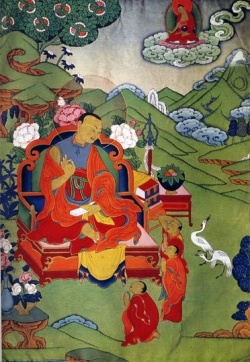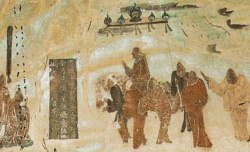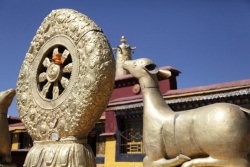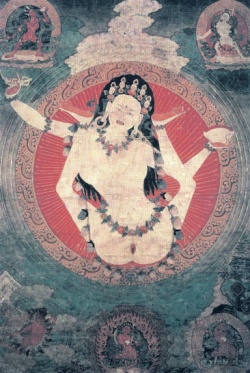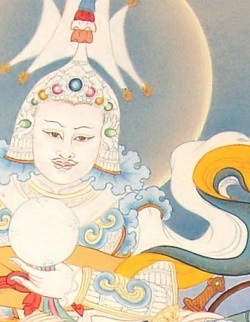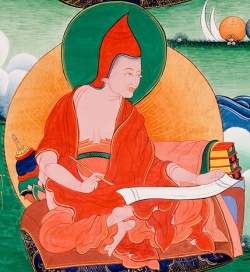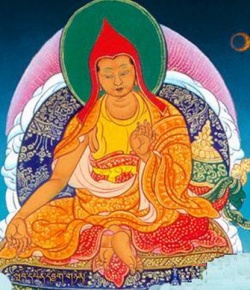Yogacara snd the Buddhist Logicians by Alex Wayman
Introduction The school of Buddhism known as Yogacara or alternately as Cittamatra is a standard topic in surveys of Indian philosophy. It is also one of the two main sides of Mahayana Buddhist philosophy, the other side being called Madhyamika. Many scholars have gone deeply into the intricacies of the Indian systems of philosophy, and the Yogacara school has not escaped their keen considerations. However, the present writer found in the course of his studies over the years that the philosophical position of these texts that emerged while he read the texts of Asahga and his followers did not bear out the standard survey explanation of the Yogacara position.
At the same time, it became apparent why some scholars—undoubtedly intelligent and capable—would come to a conclusion not verified by my own delvings into this literature. I allude to the unqualified denial of an external object, attributed to this school. Of course, if indeed the Yogacara school denies the reality of an external object, it would hardly be possible to find its position attractive to the Buddhist logicians who were to follow, since Dignaga and his successors, especially Dharmaklrti, do not deny an external object; rather they call it a svalaksana (the 'particular') and even sometimes describe it as paramartha-sat ('absolute existence'), to underscore the reality of this object of direct perception (pratyaksa). But it has been claimed by Stcherbatsky and others that there is a pronounced influence of Yogacara philosophy on Buddhist logic of the Dignaga-Dharmaklrti lineage. If we grant this, and indeed we should, there remains the problem of what is the nature of the influence and what kind of Yogacara is most affiliated to the Buddhist logician's position.
But, then, there appear to be different kinds of Yogacara. At the sutra stage, there is the Samdhinirmocanasutra and its continuation into Asanga's school, and there is the Lahkdvatdrasutra. As a kind of revealed Sastra, there is the Madhydntavibhdga, attributed to Maitreya, with Vasubandhu's commentary. Finally, there is Vasubandhu's VirnSatikd and Trimiikd. Of course there are Mahayana sutras or sutra portions besides the above that were authoritative for both the Madhyamika and Yogacara schools, and also further exegetical commentaries on the main works, as well as more independent treatises to be included in the general category of Yogacara; the present paper can barely touch upon this extensive literature. After considering certain texts of the above-named literature, I shall treat the term dlayavijndna, and, finally, some views about the Yogacara.
A. Vijnaptimdtratdsiddhi and the Samdhinirmocanasutra The Samdhinirmocanasutra is the main Yogacara scripture. Vasubandhu's two brief treatises are the form of Yogacara the most known and treated by Western scholars as to attributed Yogacara philosophical position. The introduction to Tripathi's The Problems of Knowledge in Yogacara Buddhism says:1 "Dr. Stcherbatsky has also corroborated the view that Dihnaga's Alambanapariksa simply summarizes the arguments of Vasubandhu's Vijnaptimdtratasiddhi. A comparative study of the Vimsatikd and the Alambanapariksa certainly lends support to the view of Dr. Stcherbatsky." In further support, one may observe that Vinltadeva, who wrote several well-known commentaries on Dharmaklrti's logical works, composed the commentaries, Prakarana-vimiaka-tikd and Trimsika-tika, on the two Vasubandhu treatises, perhaps as a preparation for his logic commentaries, including his commentary, Alambanapariksa-tika, on the small Dignaga work. It is necessary to treat certain terms. There is the term dlambana, employed in the title of Dignaga's work, and I render it 'consciousness-support.' Then there is the correlative subjective term, vijndna, which I usually translate 'perception.' In the summary of the master Yogacara commentator Sthiramati, from his commentary on Vasubandhu's Pancaskandhaprakarana:2 66 Now, what is vijnana? It is defined as representation (vijnapti) of a consciousness-support (alambana).
A consciousness-support is a sense object 01 a thought (citta) and a mental (caitta); Furthermore, it is of six kinds, from form (rupa) up to natures (dharma). Besides, representation is defined as apprehension (graha), ascertainment (*pratipatti), and understanding {*adhigama). It is the six evolving perceptions (pravrttivijndna) from eye-based perception up to mind-based perception (manovijndna). Notice that there is no denial of an alambana in the meaning of a sense object. Passing to Vasubandhu's two treatises, we can notice references to the ordinary situation of mankind and to the transcendental experience. In the first case, his 'representation- only' (vijnapti-matra) as applied to the normal consciousness in sentient beings is somewhat subtler than a simple denial of external things. This is clear from verse 3 of the Sanskrit Vimfatikd, containing the words, "furthermore, like the hungry ghosts (preta), so with all, there is no certainty in the stream of consciousness, upon seeing the stream of pus, and so on."3
This alludes to the Buddhist mythological theory of five or six destinies (gati), including the hungry ghosts as those disembodied spirits that are perpetually hungry and thirsty because their own consciousness pollutes what is inherently pure, making it so repulsive as to be uneatable and undrinkable. Jnanagarbha's commentary on the Maitreya chapter of the Samdhinirmocanasutra illustrates the mis-reported nature of the external object with the standard example of the stream of water which animals, hungry ghosts, men, and gods all see differently, the hungry ghosts seeing it full of pus, the gods seeing it as lapis lazuli, and so on.4 The stream itself is not denied. What those remarks mean is that the consciousness shared by a particular destiny (gati), say men, or hungry ghosts, agrees on a particular fabrication attributed to an external, and that the external is not the way it was represented. Hence, the point is not to deny an external object, but rather to affirm the representation of it as a group fabrication; and so the common denial of an external object means in these terms that there is no object of which the representation is a faithful copy.
In short, Vasubandhu could well argue that his representation-only is the correct way to speak of the nature of consciousness in the light of the Buddhist teaching of five or six destinies {gati), with the position 67 that the object is the same for all the sentient beings: they only see it differently on account of the destiny. Once we take this as Vasubandhu's position, it becomes more reasonable to assume a possible consistency with Dignaga's Alambanapariksa, since this work indeed admits an alambana. It is also well to notice that Vasubandhu treats the transcendental experience, since Dignaga also admits a yogipratyaksa. Thus toward the end of the Trimfikd (verse 28) :5 When perception (vijndna) does not perceptively reach the meditative ooject (alambana), it abides in the state of perception- only (vijndna-mdtra)y which lacks an apprehenctible by reason of not apprehending that meditative object. Here again Vasubandhu clarifies that he does not deny the alambana. The state of vijndna-mdtra is reached when vijndna does not apprehend the alambana.
Subject and object have become one in samddhi; and Vasubandhu's verse is consistent with Asanga's citation of the Samdhinirmocanasutra (Maitreya chapter) in his Mahdydnasamgraha: Lord, is that image which is the sarnddhi-domam different from that mind (wnich perceives) or is it the same? The Lord answered: Maitreya, it is not different. And why? Because that image amounts to representation-only (vijnaptimdtra). Maitreya, I have explained that the meditative object {alambana) of perception (vijndna) is distinguished (vibhakta) by representation-only (vijnaptimdtra).6 This passage again clarifies that there is no denial of the alambana even in the successful samddhi situation.
Indeed, representation- only distinguishes the consciousness-support when it is no longer perceived. This corresponds to the usual situation when, seeing something quite striking and wondering if it is really there, we would turn away from it and not see it, showing that our perception itself was not responsible for the object (here the alambana), and that the object was distinguished (set apart) by our no longer perceiving it. By the same token, the state of samddhi is distinguished by the yogin's returning to ordinary consciousness. Now, is the preceding consistent with Dignaga's Alambanapariksdl Since it is a brief work, I shall translate the eight verses with the help of Dignaga's own commentary.7 68 1. Although atoms are the cause of the sensory representation, they do not appear therein, so its sense object (visaya) is not the atoms, like a sense organ (has objects). 2. Whatever appears (i.e. in the representation) that way, does not (do so) from them, because it (the representation) is non-substantial, like a double moon. Accordingly, neither of the two externals (atoms and their aggregation) is feasible as the object of cognition. 3.
Some persons claim that the aspects (dkdra) of aggregation accomplish (the cognition), and that the aspect of atoms is not the object of representation, like solidity, etc. 4. If it were that way, the cognitions of pot, cup, etc. would be the same. If the differentiation (of cognition) is by virtue of differentiation of aspects, it would exist as atomic substance— 5. because if it were not (so), there would be no differentiation of measure (e.g., roundness). Therefore, it exists (i.e., conventionally) without material. Because if one excludes the atoms, the cognition of an appearance in that place would disappear. 6. The form of the inner knowable, which appears as though it were external, is the object—because it is the form of perception (vijndna) and because it is the conditional state (pratyayatd) of that (= dlambana). 7. And it is the condition (pratyaya) because a single part (amsa) is not delusive. Because it establishes capacity (sakti), it is in sequence. Whatever is the form of sense capacity that is an associated cause (sahakdrin), is the sense organ (itself). 8.
Besides, that does not contradict the representation. Accordingly, these (three) pass (as valid): 1) the form of the sensory object (visaya); 2) the capacity of mutual cause (i.e., capacity of eye, and based on inner form the perception, vijndna, to wit, the dlambana appearing as objective thing); 3) immemorial time. Later, we shall see by a passage of Dharmottara's that Dignaga has a kind of nominalism here. He distinguishes between the atoms and the form of atoms. What causes sensory representation is atoms, not an aggregation of 'form' of atoms. In his summary (verse 8, 2), he shows that this cause is further treated by an associated cause, to wit, the sense-organ capacity. 69 These are taken together as one item. Left over 1) is the 'form' (the so-called 'aggregation of atoms') attributed to the object; this is added by the mind, and is another item (which he calls "the form of the sensory object").
A third item is 'time,' since this is necessary for sequence, as in the discussions on various causes. So far I detect no divergence from that part of Vasubandhu's two treatises, Asahga's citation in the Mahdydna-samgraha, and Sthiramati's passage, as presented above. In this kind of nominalism8 (though called 'idealism' in Indian Philosophy surveys), what is real is the atomic object, called in other logic texts the svalaksana, and the real is causal and has the sense organ as a cooperating capacity. On top of this the mind adds the 'form,' more comprehensible by the word 'shape,' meaning that the aggregation of atoms was not what caused the perception: this aggregation is a representation-only (vijnapti-mdtra) of a consciousness-support (alambana) and makes up a picture in the mind, which the mind attributes to the external world. It is impossible that this picture or aggregation could exist in the external world, since it is representation-only. The vulgar interpretation— that this denies external objects—is nonsense. It fails to get Vasubandhu's point, or Dignaga's either.
When Vasubandhu says, "like the hungry ghosts (preta)" he intends that when they see the river as full of pus and other unclean matter, this is their representation-only; he does not deny the external object. He here appears consistent with the Maitreya chapter of the Samdhinirmocanasutra. However, Vasubandhu and Dignaga show a different emphasis. Dignaga attempts to give equal weight to the real object and the unreal object. Not particularly in this treatise, Alambanapariksd, but, rather, in his Pramdnasamuccaya, he sets forth the object of pratyaksa (sensory perception) as the svalaksana; and the object of an appropriate cognition called 'inference' {anumana) as the sdmdnyalaksana. B. Madhydntavibhaga and two 'reals' This treatise obtained a reverence tantamount to that of scripture by the legend that Asanga received it from Maitreya, understood as the Bodhisattva; and Vasubandhu's commentary 70 has a derived lustre thereby. I have cited Dharmottara's Pramdnapariksd for a passage on color and shape to show a consistency with the Madhydntavibhdga's first chapter, in an old review article of mine in Philosophy East and West. Here the philosophical position is evidently a kind of nominalism, and as was previously indicated, is apparently consistent with Dignaga's Alambanapariksd. Dharmottara is a well-known commentator on Dharmaklrti.
This is Dharmottara's passage:9 Of those, the efficient entity is the subtle atom, and color (varna) is the nature of the subtle atom, but shape (samsthdna) is not. Thus, shape exists conventionally (samvrtitas) while color exists in the absolute sense (paramdrthatas). The latter serves for an effect while shape does not. Consequently, while one ordinarily sees something efficient as a multiple, when one understands the nature of this and that, it is not distinct, for example, a moment. [It is objected:] "Shape is that way. Its existence in a distinct manner pervades as an adjunct to an entity in the sense of a distinct configuration. Just as in the absence of a thesis there is no reason, it would contradict this were the adjunct to an object (visaya) (to be) without distinctness." Now we have explained that shape is not an adjunct.
Therefore, the shape, or the 'state of a given thing' (dhos po nid, S. vastutva), or a moment, are dependent on something, whatever the something else. Here, Dharmottara takes the 'color' out there, 'shape' in the mind; the realist takes the shape and color out there. In my review article on Chatterjee's The Yogacara Idealism,™ I pointed out that the Madhydntavibhdga has two reals, the void Dharmadhatu and the Imagination of Unreality. Here, the void Dharmadhatu is on the side of the efficient entity, the color, where the Buddhist logician puts the svalaksana\ and the Imagination of Unreality is on the side of constructive imagination, discursive thought, which adds the dimension, the shape, where the logician puts his sdmdnyalaksana. For example, the clay is the atomic portion in the void Dharmadhatu, and the shape impressed upon it—consequently the 'pot'—came from the potter's mind, a vestige of the Imagination of Unreality. C, The Lahkdvatdrasutra and Cittamdtra This sutra is frequently taken to be in the Yogacara tradition, 71 since it uses freely the term dlayavijndna (though in conjunction with the Tathagatagarbha), a characteristic term of the Asanga- Vasubandhu Yogacara (which, however, does not appear to accept the Tathagatagarbha theory), and frequently employs the term cittamdtra. Suzuki, in his Studies in the Lankavatara-sutra" states that this sutra never employs the term vijndnamdtra (employed by Vasubandhu in an above citation), although it uses cittamdtra and vijnaptimatra interchangeably.
In terms of the previously-mentioned two situations from Vasubandhu's two treatises, namely, the ordinary situation of mankind, and the yogin's samadhi situation, it appears that the Lahkdvatdra uses the term cittamdtra in terms of the ordinary situation. At least, this is the conclusion of passages cited in Tson-kha-pa's commentary on Candraklrti's Madhyamakdvatdra (a work in the Madhyamika tradition). Thus, the Lanka, Chap. Ill, verse 33:u There is nothing manifested outside, for the mind manifests the multiplicity. Body, sense experience, dwelling place—I call mind-only. Tsoh-kha-pa explains:13 'body' means the material (rupin) sense bases (dyatana) of eye, etc.; 'sense experience' (bhoga) means the five sense objects, form, sound, etc.; 'dwelling place' means the receptacle world (bhdjana-loka).
While they are all manifested by the mind, they appear as though external. Tsori-kha-pa calls this a sutra of 'provisional meaning' in the Madhyamika meaning of the terms neydrtha (provisional meaning) and nltdrtha (final meaning). He claims that such sutra passages as this one were taught by the Lord to divert sinful beings from their attachment to sense objects; and so they are provisional. He bears this out by citing another verse from the Lanka, Chap. II, 123:u In the way that a physician offers a medicine to one patient and a medicine to another patient, in that way the Buddhas teach mind-only for the sentient beings. Thus the teaching of mind-only is subservient to the particular sentient beings that are taught.
This application of the Mahay ana 'skillful-means' (updya-kausalya) approach, in contrast to what is actually the case, would hardly be inviting to the Buddhist logicians. On the other hand, it is possible to take the term cittamdtra 72 in a meditative context. Perhaps consistent with those Lahkavatara verses is what Sthiramati says in his subcommentary on the Mahdydna-Sutralamkdra, Bodhipaksa chapter, verse 66: "The halting of thought on such a single area of thought as 'Mind-only is the three worlds; they are nothing but the mind,' constitutes calming (of the mind) (samatha)."*5 That is, he here counts the passage "Mind-only is the three worlds" as a meditative object in the form of an aphoristic sentence, rather than as a philosophical tenet of ordinary discursive thought.
This meditative sense of the term cittamatra is also in the Sutrdlamkdra itself, Chap. XIV, verses 24-25, during an explanation of the four degrees of yoga—warmth, summits, forbearances, and supreme mundane natures:15 So as to expand the light of dharma, he begins striving in earnest. And having expanded the light of dharma, he stands fast in mind-only {cittamatra). Then he discerns the appearance of all objects in the citta. At that time there are cast off his shifting objects of perception. In these meditative passages, it could be argued, the sense of mdtra in cittamatra, i.e. 'only,' as excluding external objects, is not to do away with external objects, but to disregard them, since this situation of samadhi is purely an interior movement. D. The dlayavijndna In the Siddhanta book of the Tibetan author Dkon-mchog- 'jigs-med-dbah-po, the Yogacarins {sems tsam pa) are divided into two: those who follow scripture (dgama-anusdrin), and those who follow reason (yukti-anusdrin). The former are those who follow the five divisions of Asanga's Yogdcdrabhumi.
The latter are those who follow the seven treatises of logic (by Dharmaklrti). Worthy of note is the difference attributed to the two regarding their theory of the 'subjective' (visayin, T yul can): "The followers of scripture accept the dlayavijndna as the personality (pudgala) because they believe in the eight kinds of vijndna. The followers of reason believe in the mano-vijndna as the basic characteristic of the personality."17 I have pointed out in another study that the Buddhist logicians apparently replaced the dlayavijndna with the kind of pratyaksa called 'in- 73 trospection' (svasamvedana)™ However, Dharmaklrti, in his Pramdnavdrttika, Pratyaksa chapter, verse 522, refers to the alaya, which Prajnakaragupta in his commentary explains as the alayavijnana. The commentarial passage is quite difficult, and here I shall just give the gist of it. First, there are verses 521 and 522 by Dharmaklrti:19 521.
When capacity ends for the previous cognition, there is no cognition in the absence of the prior cognition, because one does not understand the arising of a cognition in the event the cognition loses the capacity for another object. 522. Although the two, unaffiliated, have arisen simultaneously by means of a single perspicacious thought (= evolving perception), since loss of capacity has set in, there is no arising of another from the alaya. Dharmaklrti here refers to the situation where a cognition of an object is dissipated and there is a problem of accounting for the next cognition. But do we have to bring in the help of a 'store-consciousness' (alayavijnana) to get the next cognition? It seems that DharmakTrti denies any need of the alayavijnana. However, Prajnakaragupta concludes: "Let this thought (cintd) of alayavijnana stay! Besides, since it is imagined as the basis of 'habit-energy' (vasana), there is no fault."20 This reference to vasana recalls the discussion earlier in this paper about Vasubandhu's 'representation-only' in terms of the destiny distortion, e.g. the hungry ghosts. Standard Buddhist tenets relate this to the karma theory.
Thus, Tsoh-kha-pa, in his Tibetan commentary on Candraklrti's Madhyamakdvatara, which refutes the alayavijnana, mentions four theories to account for effectiveness of karma. In brief, the four are: 1. that of certain 'mind-only' (cittamdlra) followers, who resort to the alayavijnana to account for it; 2. that of a Vaibhasika school outside of Kashmir, as is explained by Avaiokitavrata (a voluminous commentator on Bhavaviveka's Prajndpradipa), crediting the samskdras (motivations) with an indelible record of the debt to be paid; 3. that of the standard Vaibhasika school, which claims that the dhanna called 'reach' (prapti) has the capacity to reach the fruit; 4. that of a number of persons, both Vaibhasika and Sautramika, who held that the stream of 74 vijndna is suffused (from Chinese texts one would say 'perfumed') with the habit-energy (vdsand) of karma (the volitional act).21 In short, some Cittamatra followers appealed to the alayavijndna alone for effectiveness of karma. Some others took samskdras alone. Some decided on a special force called 'reach1. Finally, some combined vijndna and samskdras, without an alayavijndna, for the karma role.
Prajnakaragupta apparently means that the Buddhist logicians treat the problem of perception and inference without bringing in the notion of alayavijndna; and for all that, not necessarily rejecting it in terms of the karma theory. E. Do the Yogdcdrins deny an external object? Japanese scholars have in recent years published a number of books dealing with the Yogacara, usually by the name Vijnaptimatra, as a topic in itself, or in comparison with the Madhyamika. When I was in Kyoto in 1970, I spoke with one of these authors, Professor Masaaki Hattori, who had recently published such a book, in collaboration with a philosopher, Professor Shunpei Ueyama.
I mentioned that I had failed to find any denial of an external object when I read the mirror simile passage22 in the Maitreya chapter of the Samdhinirmocanasutra and as it was taken over by Asahga in his Mahaydnasamgraha along with Vasubandhu's comment; or when I read the extensive material on that simile passage in Yuan-ts'e's great commentary on the Samdhinirmocana that was translated into Tibetan; or when I read Jnanagarbha's commentary on the Maitreya chapter. It seemed to me that these authors took the external entity for granted, but were silent about it because the sutra itself was concerned with the samddhi image, which is not derived from the reflex in consciousness of an external object. Dr. Hattori agreed with me that the Samdhinirmocana there was silent about an external rather than in denial of it.
But he added: the later Yogacara school stems from the Vijnaptimatrata after Vasubandhu, and in this developed school there is definitely a denial of the external object. I am pleased to mention this agreement on the thesis I have been advancing in this paper, since my own considerations of the Yogacara in comparison with the Buddhist logicians go up 75 to Vasubandhu and his commentator Sthiramati; and so far, anyway, there is no denial of the external object, but rather a stress on its mis-reported nature. Professor Hattori's book is called Ninshiki to Choetsu (yuishiki) (Tokyo, 1970). In response to a later inquiry, he wrote me, among other things, that the terms 'Ninshiki' (cognition) and 'Choetsu' (Transcendence/The Act of Transcending) in the title of his book "stand respectively for the theoretical and the practical aspects of the Yogacaravijnanavada."
After writing the foregoing, I found a corroboration from a work of Tsoh-kha-pa, founder of the Gelugpa sect of Tibetan Buddhism. He said, referring to the Samdhinirmocanasutra, "In that sutra it is clearly stated that the denial of an external is in the phase of calming (the mind)."23 However, even granted that the Samdhinirmocanasutra, the basic scripture of Yogacara, did not deny an external object except for in the samddhi situation, it should be acknowledged that various scholars have understood Vasubandhu's Vims'atikd Vijnaptimdtratdsiddhi to have denied an external object without reference to the samddhi situation.
But the opening gloss, which seems to indicate such a denial, can be understood differently. Explaining the term "representation-only" {vijnaptimdtra), it defines the "only" this way: mdtram ity arthapratisedhdrtham ("only" means negation of an object). Here the word artha is properly taken as "external object." The word pratisedha is known in Indian logic, including Buddhist logic, to have two kinds, "simple negation" (prasajya-pratisedha) and "qualified negation" (paryuddsa). The interpretation that this treatise of Vasubandhu's has denied an external object without qualifications opts for the "simple negation." In the light of passages previously cited from his two treatises, it is reasonable to opt for the "qualified negation." It is qualified because for the ordinary situation of life Vasubandhu indicates that the representation differs for the various destinies of men, hungry ghosts, etc.; and because for the special case of the yogin, "representationonly" concerns the samddhi situation.
Conclusion As I long ago pointed out in the review article on the Chatterjee book, the belief of some that the Yogacara system admits 76 a sole reality, called Mind-only, does not prevent Chatterjee or any number of other authors of East and West from writing good books on the topic, with refined philosophical sentences. But problem-solving is of a different nature. It should have been intriguing, to say the least, that the Buddhist logicians should be classified as 'Yogacarins' if these Yogacarins deny an external object and those logicians affirm it, insisting on the reality of the momentary object of direct perception (pratyaksa).
Because Ratnakarasanti comes near the end of the Buddhist period in India and follows the Yogacara position in certain independent treatises, while having also written a little text of Buddhist logic, I should like to close with a passage from a commentary of his on the Guhyasamdjatantra: "Because the mental burnt-offering (homa) is 'mind-only,' one should understand it as not dependent on an external thing."24 - . * • • * * • » < \.. ••, NOTES N^£V" 1. The introduction by Sangam Lai Pande to C. L. Tripathi, The Problems of Knowledge in Yog&c&ra Buddhism (Varanasi, 1972), p. xiv. 2. Photographic edition of Peking Tibetan canon (PTT), Vol. 114, The Paficaskandha-prakarana-vaibhdsya, p. 20-1,2. 3. . . . pretavat punah / samtananiyamah sarvaih puyanadyadidarsane // 4. Aryasamdhinirmocanasutre Aryamaitreya-kevala-parivarta-bhdsya, PTT, Vol. 109, p. 198-4. 5. yadalambanam vijnanam naivopalabhate tada / sthitam vijnanamatratve grahyabhave tadagrahat // 6. Etienne Lamotte, Samdhinirmocana Sutra (Louvain, Paris, 1935), pp. 90- 91,211; also Lamotte, La Somme du Grand Vehicule d'Asanga (Mahdydnasamgraha) (Louvain, 1938, 1939), Chap. II. 7. Translated from the Tibetan texts (in transcription) contained in N. Aiyaswami Sastri, Alambanaparfksd and Vrlti by Dinndga with the Commentary of Dharmapdla (The Adyar Library, 1942).
However, Sastri's reconstructed Sanskrit and other materials were not employed for my translation. 8. Cf. Ernst Steinkellner, "Yogische Erkenntnis als Problem in Buddhismus," in Transzendenzerfahrung, Vollzugshorizont des Heils, ed. by G. Oberhammer (Wien, 1978), p. 131, for the observation that the entire school of Buddhist logic has a nominalist position in the theory of concepts. 9. PTT, Vol. 138, p. 63-2-1. As translated with Tibetan cited in A. Wayman, "Reflections on the Study of Buddhist Logic," forthcoming Indologica Taurinensia. 77 10. Philosophy East and West, XV: 1, Jan. 1965. 11. Daisetz Teitaro Suzuki, Studies in the Lankavatara Sutra (London, 1930), p. 181. 12. The Lankdvat&ra Sutra, ed. by Bunyiu Nanjio (Kyoto, 1956), p. 154: drSyam na vidyate bahyam cittam citram hi drSyate / dehabhogapratisthanam cittamatram vadamy ahatn // 13. Tson-kha-pa, the Dbu ma la 'jugpa'i rgya cher Mad pa 'Dgonspa rob gsal' Us bya ba, PTT, Vol. 154, p. 74-1-7,8. 14. The Lankavat&ra Sutra, p. 49: ature ature yadvad bhisag dravyam prayacchati / buddha hi tadvat sattvjinam cittamatram vadanti vai // 15. PTT, Vol. 109, p. 61-1-3: / khams gsum thams cad ni sems tsam du zad pa ste / sems las glan med do zes sems rtse gcig tu 'jog pa ni zi gnas zes bya ste /.
This passage was called to my attention by a former student, Shinj6 Kawasaki, now a professor at the Tsukuba University, Tokyo. 16. Sylvain Levi, ed., Mahaydna-Sutralamhara, p. 93: dharmalokasya vrddhyartham viryam Srabhate drdham / dharmalokavivrddhya ca cittamatre 'vatisthate // sarvarthapratibhasatvam tataS citte prapaSyati / prahlno grahyaniksepas tada tasya bhavaty asau // 17. Dkon-mchog-jigs-med-dbari-po, Grub pa'i tntha'i rnam par bzag pa rin po che'i phreh ba (edition of Dha-sa-$es-rig press of India, 1967), p. 49. 18. The article "Reflections on the Study of Buddhist Logic," n. 8, above. 19. Rahula Sankrityayana, ed., Pramdnav&rtikabhashyam of Vdrtikdlahkarah of Prajndkaragupta (K. P. Jayaswal Institute, Patna, 1953), p. 457: 521. saktiksaye purvadhiyah nahi dhlh pragdhiya vina / anyarthaSaktivigune jnane jnanodayagateh // 522. sakrdvijatiyajatav apy ekena patlyasa / cittenahitavaigunyad alayan nanyasambhavah // 20. Sankrityayana, ed., Prajnakaragupta, p. 457: astam iyam alayavijnanacinta / vasanadharataya va parikalpitan tad iti na dosah /. 21. Tsori-kha-pa (cf. n. 12, above), PTT, Vol. 154, p. 52-5 to p. 53-2. 22. This mirror simile goes with the passage cited above, per n. 6. 23. Tsoh-kha-pa's Drah hes legs Mad snih po (Sarnath ed., 1973, p. 73): mdo de las zi gnas kyi skabs su ni phyi rol dgag pa gsal bar gsuns so /. 24. Sriguhyasamdja-mandalavidhi-tika, PTT, Vol. 65, p. 155-2: yid kyi sbyin sreg ni sems tsam yin pas phyi rol la bltos pa med par ies par bya'o.


